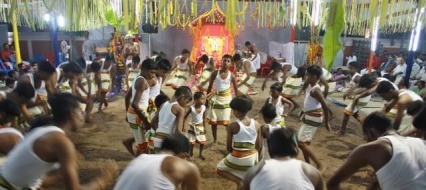Kuttiyottam

Kuttiyottam is one of the main offerings at the Chettikulangara Devi Temple.It is a ritualistic symbolic representation of human bali (homicide).A team of artists perform this song and dance ritual. The songs include those in praise of Durga and other deities, padapattu (war songs) and kalaripattu (martial art songs). Instrumental accompaniments are mainly percussions, ganjira, bells and chaplankatta. Faces are painted and red curtains are used as partitions on the stage
Young boys between 8 to 14 years are taught Kuthiyottam, a ritual dance in the house amidst a big social gathering before the portrait of the deity. Early in the morning on Bharani, after the feast and other rituals, the boys whose body is pierced with a silver wire, one end of which is tied around his neck and an arecanut fixed on the tip of a knife held high over his head are taken in procession to the temple with the accompaniment of beating of drums, music, ornamental umbrellas, and other classical folk art forms, and richly caparisoned elephants.All through the way to the temple tender coconut water will be continually poured on his body. After the circumambulation the boys stands at a position facing the Sreekovil(Sanctum Sanctorum) and begins to dance. This ceremony ends with dragging the wire pierced to the skin whereby a few drops of blood comes out. Kuthiyotta Kalaris’, run by Kuthiyotta Asans (Teachers or leaders), train the group to perform the dances and songs. Normally, the training starts about one to two months before the season
Folklore exponents see this art form, with enchanting well structured choreography and songs, as one among the rare Adi Dravida folklore traditions still preserved and practiced in Central Kerala in accordance to the true tradition and environment. Typical to the Adi Dravida folk dances and songs, the movements and formations of dancers (clad in white thorthu and white tshirt) choreographed in Kuthiyottam are quick, peaks at a particular point and ends abruptly. The traditional songs also start in a stylish slow pace, then gain momentum and ends abruptly. On this day just after midday the residents of the locality bring huge decorated effigies of Bhima, Panchali, Hanuman and extremely beautiful tall chariots in wheeled platforms, and after having darshan the parties take up their respective position in the paddy fields lying east of the temple.During the night, the image of Devi will be carried in procession to the effigies stationed in the paddy fields. On the next day these structures will be taken back.
Young boys between 8 to 14 years are taught Kuthiyottam, a ritual dance in the house amidst a big social gathering before the portrait of the deity. Early in the morning on Bharani, after the feast and other rituals, the boys whose body is pierced with a silver wire, one end of which is tied around his neck and an arecanut fixed on the tip of a knife held high over his head are taken in procession to the temple with the accompaniment of beating of drums, music, ornamental umbrellas, and other classical folk art forms, and richly caparisoned elephants.All through the way to the temple tender coconut water will be continually poured on his body. After the circumambulation the boys stands at a position facing the Sreekovil(Sanctum Sanctorum) and begins to dance. This ceremony ends with dragging the wire pierced to the skin whereby a few drops of blood comes out. Kuthiyotta Kalaris’, run by Kuthiyotta Asans (Teachers or leaders), train the group to perform the dances and songs. Normally, the training starts about one to two months before the season
Folklore exponents see this art form, with enchanting well structured choreography and songs, as one among the rare Adi Dravida folklore traditions still preserved and practiced in Central Kerala in accordance to the true tradition and environment. Typical to the Adi Dravida folk dances and songs, the movements and formations of dancers (clad in white thorthu and white tshirt) choreographed in Kuthiyottam are quick, peaks at a particular point and ends abruptly. The traditional songs also start in a stylish slow pace, then gain momentum and ends abruptly. On this day just after midday the residents of the locality bring huge decorated effigies of Bhima, Panchali, Hanuman and extremely beautiful tall chariots in wheeled platforms, and after having darshan the parties take up their respective position in the paddy fields lying east of the temple.During the night, the image of Devi will be carried in procession to the effigies stationed in the paddy fields. On the next day these structures will be taken back.
